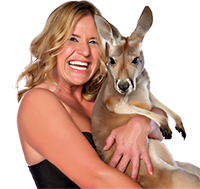 | Kangaroo LanieAmerica's Wild Girl | 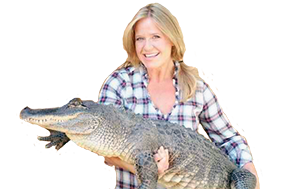
|
..And Her Animal Friends Seen at Events Nationwide | ||
|
| 

|
"I dressed as a lion tamer for my preschool graduation and trained a little boy dressed as a lion to jump through a hoop...I've never actually trained a lion since, nor have I taught any animal to jump through a hoop...But I am working hard to train a generation to love and respect this wild planet...one heart at a time"
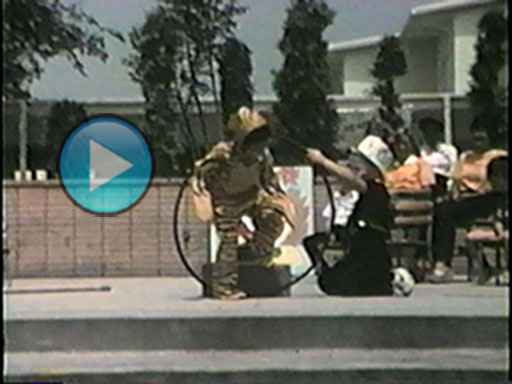
My favoriate animal is the kangaroo. You can always tell by the smile on my face.
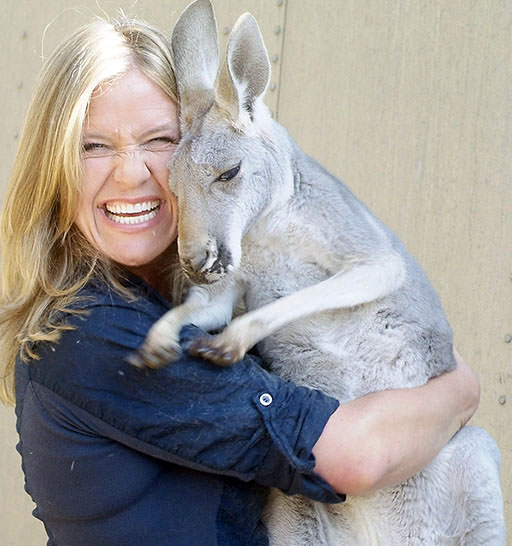
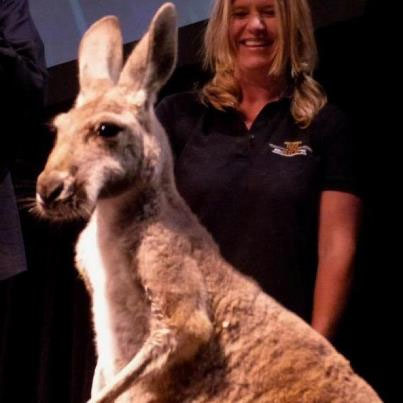
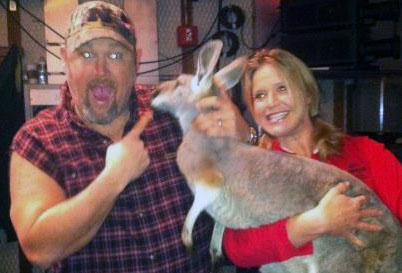
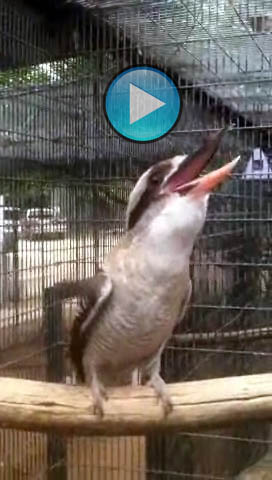 `
`
This Australian bird is the largest of the kingfishers and definitely the funniest! Known as the laughing kookaburra this rather small bird has a call that is both very loud, long, and downright funny - it sounds like laughter! The sound bite of the kookaburra's call has been used in the film and television industry for many years to imitate jungle noises and monkey sounds. The irony is that this kingfisher does not live on a continent with monkeys! It lives throughout many habitats in Australia and is often referred to as the bush mans alarm clock.
The kookaburra's long beak helps them to catch a variety of prey including insects, fish, small mammals and even snakes and lizards! Once they catch prey they beat it against tree branches and then swallow it hole - even long snakes!!
The kookaburra's name is a word from Wiradjuri guuguubarra, and is onomatopoeic of its call. Meaning that the name kookaburra is actually the sound that they make. An analogy would be if we referred to a dog as a ruff or a cat as a meow!
Giggles the kookaburra was with me at a special live appearance with Jungle Jack Hanna when the great grandchildren of Captain and Maria Von Trapp from the Sound of Music- Justin, Amanda, Melanie and Sofia Von Trapp performed live at the show. Justin Von Trapp made the kookaburra call during their rendition of a song from the Lion King. We all thought Giggles would be inspired by Justin's perfect call and join in...but instead he sat silently on my hand and just stared in awe at Justin and the other Von Trapp children! Can't say I blamed my feathery friend - I was staring in awe of their angelic voices too!!
 `
`
The clouded leopard (Neofelis nebulosa) is a felid found from the Himalayan foothills through mainland Southeast Asia into China, and has been classified as vulnerable in 2008 by IUCN. Its total population size is suspected to be fewer than 10,000 mature individuals, with a decreasing population trend and no single population numbering more than 1,000 adults.
The fur of clouded leopards is of a dark grey or ochreous ground-colour, often largely obliterated by black and dark dusky-grey blotched pattern. There are black spots on the head, and the ears are black. Partly fused or broken up stripes run from the corner of the eyes over the cheek, from the corner of the mouth to the neck, and along the nape to the shoulders. Elongated blotches continue down the spine and form a single median stripe on the loins. Two large blotches of dark dusky-grey hairs on the side of the shoulders are each emphasized posteriorly by a dark stripe, which passes on to the fore leg and breaks up into irregular spots. The flanks are marked by dark dusky-grey irregular blotches bordered behind by long, oblique irregularly curved or looped stripes. These blotches yielding the clouded pattern suggest the English name of the cat. The underparts and legs are spotted, and the tail is marked by large irregular paired spots.
Their legs are short and stout, with broad paws. They have exceptionally long, piercing canine teeth, the upper being about three times as long as the basal width of the socket.[5] The upper pair of canines may measure 4 cm (1.6 in) or longer.
Clouded leopards are native to Indochina, Thailand, Peninsular Malaysia, Myanmar, Bhutan, Bangladesh, India, and Nepal. They are regionally extinct in Taiwan, and occur marginally in mixed-evergreen forests of the northeastern and southeastern parts of Bangladesh.[2] In the Himalayan foothills of eastern India they have been recorded up to an altitude of 1,450 m (4,760 ft).[8] They have been reported from relatively open, dry tropical forest in Myanmar and Thailand.[9] They prefer open- or closed-forest habitats to other habitat types.
In Assam, they have been observed in forests but have not been recorded in protected areas.[11] They occur in northern West Bengal, Sikkim, Arunachal Pradesh, Manipur, Meghalaya, Mizoram, Nagaland and Tripura.
Clouded leopards were believed to be extinct in Nepal, the last published record being from 1863. But in 1987–1988 four individuals were found in the country. These findings extended their known range westward suggesting that they are able to survive and breed in degraded woodlands and scrub previously supporting moist subtropical semi-deciduous forest.
Clouded leopards are the most talented climbers among the cats. In captivity, they have been observed to climb down vertical tree trunks head first, and hang on to branches with their hind paws bent around branchings of tree limbs. They are capable of supination and can even hang down from branches only by bending their hind paws and their tail around them. When jumping down, they keep hanging on to a branch this way until the very last moment. They can climb on horizontal branches with their back to the ground, and in this position make short jumps forward. When balancing on thin branches, they use their long tail to steer. They can easily jump up to 1.2 m (3.9 ft).
Clouded leopards have been observed to scent mark in captivity by urine spraying and head-rubbing on prominent objects. Presumably such habits are used to mark their territory in the wild, although the size of their home ranges is unknown. Like other big cats, they do not appear able to purr, but they otherwise have a wide range of vocalisations, including mewing, hissing, growling, moaning, and snorting. Apart from information stemming from observations of captive clouded leopards, little is known of their natural history and behavior in the wild. Early accounts depict them as rare, secretive, arboreal and nocturnal denizens of dense primary forest. More recent observations suggest that they may not be as arboreal and nocturnal as previously thought. They may use trees as day time rest sites but also spend a significant proportion of time on the ground. Some daytime movement has been observed suggesting that they are not strictly nocturnal but crepuscular. However, the time of day when they are active depends on their prey and the level of human disturbance.
Their partly nocturnal and far-ranging behaviour, their low densities, and the fact they inhabit densely vegetated habitats and remote areas makes the censusing and monitoring of clouded leopards extremely difficult. Consequently, little is known about their behaviour and status. Available information on their ecology is anecdotal, based on local interviews and a few sighting reports.
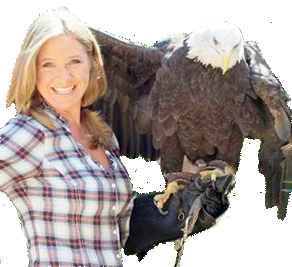 | Copyright 2012-2024, Kangaroo Lanie -- All Rights Reserved | 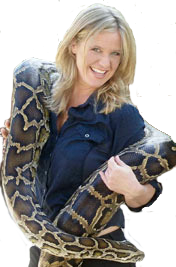
|
..And Her Animal Friends Seen at Events Nationwide | ||
|
| ||
|
Make sure to visit the Conservation Ambassadors Website. |